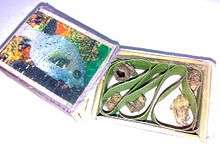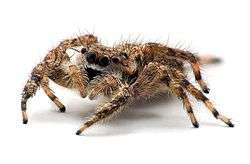Spider fighting

Spider fighting or spider derby is a blood sport involving spiders that occurs in different forms in several areas of the world. Among them are the Philippines, Japan, and Singapore. The fights that occur in the Philippines and in Japan are staged between females of various species of web weavers. Female spiders will kill a rival if the loser does not quickly flee or receive the aid of a human handler. The contests that are staged in Singapore are fights between male jumping spiders. The males fight only for dominance, and ordinarily the loser will flee, though sometimes they will lose a leg in the fight.
In the Philippines, spider fighting (Hiligaynon: pahibag sang damang; Cebuano: paaway kaka or sabong sa kaka) is staged between female orb-weavers from the genus Neoscona.[1] In Japan, the contests occur at an annual festival and use females of the genus Argiope. In Japanese these contests are called Kumo Gassen (spider battles). In Singapore, they use males of the genus Thiania, and most commonly use the species Thiania bhamoensis, although another species of that genus may sometimes be used. Like cockfighting, spider fighting is a sport that usually involves betting and events occur frequently. In Singapore, they are known as "fighting spiders" in English and dòu zhī zhū (Chinese: 鬥蜘蛛, "fighting spiders") in Mandarin Chinese, analogous to the Chinese term for gamecocks, dòu jī (Chinese: 鬥雞, "fighting chickens").
Philippines

Spider fighting (Hiligaynon: pahibag sang damang; Cebuano: paaway kaka or sabong sa kaka) is a popular blood sport among rural Filipino children, especially in the Bisaya region. The game begins by placing two spiders at opposite ends of a stick. The spiders are then prodded to move along the length of the stick until they encounter each other and fight.[2]
Catching

Spiders suitable for spider fighting are almost always adult female orb-weavers from the genus Neoscona. Only the spiders coming from this genus are called damang or kaka (or in English as "derby spiders" or "fighting spiders"). The most commonly utilized species is Neoscona punctigera, but other species used include: Neoscona aldinei, Neoscona ampoyae, Neoscona facundoi, Neoscona lipana, Neoscona marauoyi, Neoscona nautica, Neoscona rumpfi, Neoscona shereeae, Neoscona theisi, and Neoscona vigilans.[1]
The spiders are usually caught in trees and bushes in the early morning or during dusk when the spiders come out to spin webs.[3] After capture or in-between fights, the spiders are stabled in used matchboxes.[3] These matchboxes usually have separate cells to house several spiders. The cells are normally made from discarded cardboard or a single blade of coconut leaf bent several times inside the matchbox. Some trainers assemble a "langsaranan" where the spider is released to a plant enclosed by a net or a plastic bottle with tiny holes.
Fighting
Most spider fights are done with a single piece of dried coconut leaf midrib (usually taken from a broom made from such midribs; Cebuano: gungi, Tagalog: walis tingting) or bamboo. Spiders are placed at both ends and encouraged to move toward each other and fight. The sticks are thin enough to ensure that the spiders have no choice but to meet. It is held by one child who ensures that the spiders do not escape by alternately switching grip from one end to the other. How a fight ends is agreed upon beforehand. Fights to the death will end with one spider being bitten, paralyzed, and swiftly wrapped in silk. Non-lethal matches end when one spider falls from the stick (once or several times, depending on the agreement). Occasionally, the child holding the stick may need to quickly intervene in a non-lethal fight to prevent the winning spider from eating the losing spider.[3][4]
More formal fights, called "kaka derbies" are held in an arena made of two poles connected by a tight string. Underneath is a padding (usually polystyrene foam) to ensure that the spiders are not injured in case they fall down. A fight that includes large sums of money normally has a kuyme (referee) similar to cockfighting.
Legal issues
The practice is now generally discouraged since it affects the educational performance of school children.[5] Top fighters can fetch up to 100 pesos (US$ 2),[4] making the sport lucrative for children. They could spend so much time hunting and training spiders that lessons and homework are neglected. Adults also play the sport but in a way similar to cockfighting. Derbies are also held and bets could go as high as 50,000 pesos (about US$1,000).[4] The cheaper maintenance cost of raising spiders compared to raising fighting cocks caused some players to switch to spider fighting.[6]
Ordinances against the sport are now in effect in some cities.[3][7] In the Negros Occidental province, spider derbies are treated as a threat to public morals. The Bacolod City police provincial director issued an order warning residents of participating in a form of illegal gambling.[4]
Japan
.jpg)
An annual spider fighting contest called Kumo Gassen is held in Kajiki, Kagoshima, Japan.[8] The spiders used in this contest belong to the genus Argiope. This form of spider fighting is said to have been around as far back as the 16th century. It is done in a similar manner to Philippine spider-fights. One spider, designated as the "Kamae" is placed on the end of a stick, while another spider called the "Shikake" is placed on the other end. The spiders will then fight each other in the middle. The contest is a tournament, with the last two victorious spiders fighting each other in the finale.[9]
Singapore
Spiders used in spider derbies in Singapore come from the species Thiania bhamoensis (also called "Fighting Spider"), a jumping spider.[10] The practice has been the subject of a memoir entitled Spider Boys, and a popular television series in Singapore called Fighting Spiders. Capturing, admiring, nurturing, and staging fights among these spiders is a popular activity among many young people. The practice had a relatively large financial impact on those young people who participate in these practices both because of the sale value of a strong contender and also because of the bets made on their fights. Mainly in the 60s, 70s.
United States
In the United States, spider-fighting is also prevalent in prisons in Florida, where inmates catch them and keep them in boxes as pets. In 2002, a fight between three inmates over the theft of a pet spider resulted in life-threatening skull injuries to one inmate and additional charges to the other two.[11]
Gallery
-

Top frame: Both spiders size each other up; Bottom frame: The spiders grapple; at this point, one of the spiders may have already delivered a paralyzing bite to its opponent's body
-

The victor begins to wrap its victim in silk. Spinnerets are visible
-

Top frame: The victor may be delivering another bite to its wrapped opponent; Bottom frame: The victor climbs up its dragline, dragging the wrapped victim behind using one of its hind legs
See also
References
- 1 2 Aimme Lynn A. Barrion; Adelina A. Barrion & Alberto T. Barrion (2001). "Diversity of Philippine derby spiders Neoscona species". Transactions of the National Academy of Science and Technology Philippines. 23: 280.
- ↑ "Slow Suspense". Bulatlat.com. 2005-10-23. Retrieved 2007-05-18.
- 1 2 3 4 Martin Overton (August 8, 1998). "Spider Fighting". The Tarantula's Burrow. Retrieved December 2, 2014.
- 1 2 3 4 GMANews.TV (August 21, 2007). "Sun.Star: Negros folk bet as high as P50,000 on spider derbies". GMA News. Retrieved December 2, 2014.
- ↑ "Spider wrestlers put on hold". BBC News. 1998-06-30. Retrieved 2007-05-18.
- ↑ Espejo, Edwin G. (2005-10-28). "Games big boys play". Sun.Star General Santos. Retrieved 2007-05-18.
- ↑ "Dad asks City Hall: Go after 'spider men'". Sun.Star Cebu. December 2, 2012. Retrieved 2007-05-18.
- ↑ Sekine, M. "Not A Cockfight But A Spider-Fight: Kajiki". Retrieved 2007-08-22.
- ↑ "Spider Fighting". Retrieved December 18, 2010.
- ↑ Li, D., Yik, S.H. & Seah, W.K. (2002). "Rivet-like nest-building and agonistic behaviour of Thiania bhamoensis, an iridescent jumping spider (Araneae: Salticidae) from Singapore" (PDF). Retrieved 2007-08-22.
- ↑ Mike Wilson (January 3, 2003). "You don't mess with an inmate's spider". St. Petersburg Times. Retrieved September 6, 2012.


